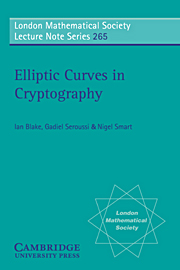Book contents
- Frontmatter
- Dedication
- Contents
- Preface
- Abbreviations and Standard Notation
- Chapter I Introduction
- Chapter II Finite Field Arithmetic
- Chapter III Arithmetic on an Elliptic Curve
- Chapter IV Efficient Implementation of Elliptic Curves
- Chapter V The Elliptic Curve Discrete Logarithm Problem
- Chapter VI Determining the Group Order
- Chapter VII Schoof's Algorithm and Extensions
- Chapter VIII Generating Curves using Complex Multiplication
- Chapter IX Other Applications of Elliptic Curves
- Chapter X Hyperelliptic Cryptosystems
- Appendix A Curve Examples
- Bibliography
- Author Index
- Subject Index
Chapter I - Introduction
Published online by Cambridge University Press: 05 August 2013
- Frontmatter
- Dedication
- Contents
- Preface
- Abbreviations and Standard Notation
- Chapter I Introduction
- Chapter II Finite Field Arithmetic
- Chapter III Arithmetic on an Elliptic Curve
- Chapter IV Efficient Implementation of Elliptic Curves
- Chapter V The Elliptic Curve Discrete Logarithm Problem
- Chapter VI Determining the Group Order
- Chapter VII Schoof's Algorithm and Extensions
- Chapter VIII Generating Curves using Complex Multiplication
- Chapter IX Other Applications of Elliptic Curves
- Chapter X Hyperelliptic Cryptosystems
- Appendix A Curve Examples
- Bibliography
- Author Index
- Subject Index
Summary
We introduce the three main characters in public key cryptography. As in many books on the subject, it is assumed that Alice and Bob wish to perform some form of communication whilst Eve is an eavesdropper who wishes to spy on (or tamper with) the communications between Alice and Bob. Of course there is no assumption that Alice and Bob (or Eve) are actually human. They may (and probably will) be computers on some network such as the Internet.
Modern cryptography, as applied in the commercial world, is concerned with a number of problems. The most important of these are:
Confidentiality: A message sent from Alice to Bob cannot be read by anyone else.
Authenticity: Bob knows that only Alice could have sent the message he has just received.
Integrity: Bob knows that the message from Alice has not been tampered with in transit.
Non-repudiation: It is impossible for Alice to turn around later and say she did not send the message.
To see why all four properties are important consider the following scenario. Alice wishes to buy some item over the Internet from Bob. She sends her instruction to Bob which contains her credit card number and payment details. She requires that this communication be confidential, since she wants other people to know neither her credit card details nor what she is buying.
- Type
- Chapter
- Information
- Elliptic Curves in Cryptography , pp. 1 - 10Publisher: Cambridge University PressPrint publication year: 1999
- 1
- Cited by



